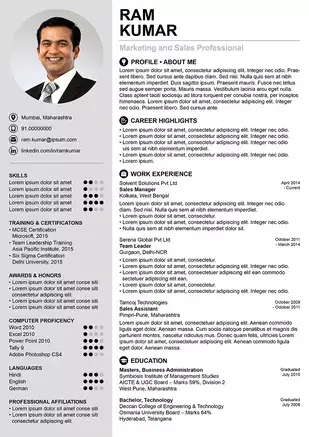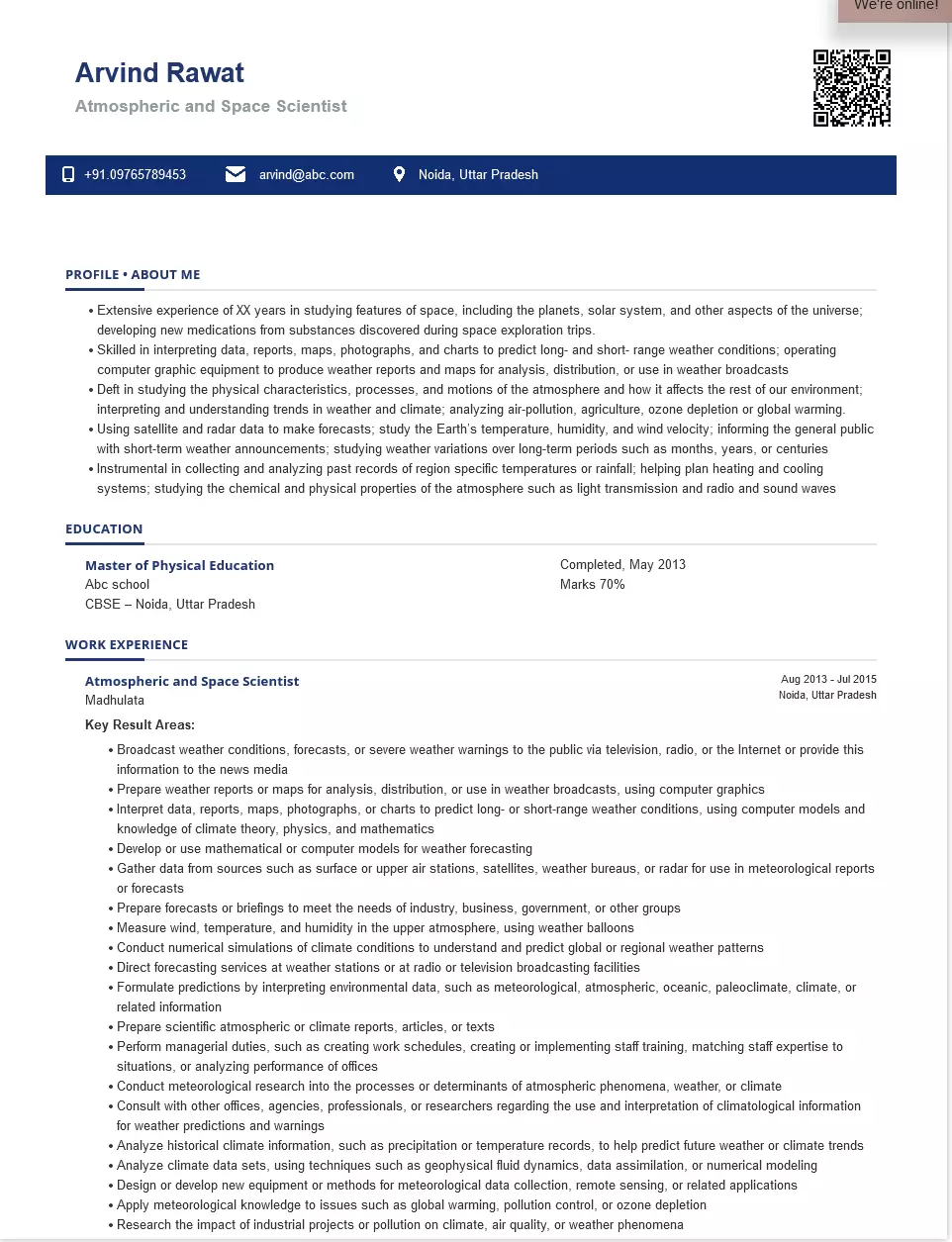- Certified Consulting Meteorologist certification, Completed , January 2019
What's your job?
Atmospheric and Space Scientists Resume Samples and Templates for 2026
- Table of Contents
- Downloadable Sample
- Resume Tips from Experts
- Resume Text Version
- Share
Ultimate Guide to Atmospheric and Space Scientists Resume Examples and Templates
Creating a resume that truly showcases your skills as an atmospheric and space scientist is a key step toward securing opportunities in research institutions, government agencies, or environmental organizations. A well-structured scientist resume should highlight technical expertise, research experience, and contributions to atmospheric and environmental science projects. Whether you’re an entry-level researcher or a senior professional, crafting a winning resume can help you stand out to any hiring manager.
Understanding the Atmospheric and Space Scientist Role
An atmospheric scientist or space scientist typically works on projects involving atmospheric science, environmental monitoring, remote sensing, and data analysis. Professionals in this field often collaborate with government agencies, universities, and private sector companies to conduct environmental impact assessments, develop predictive models, and analyze satellite data for environmental research.
The role requires a solid foundation in environmental science, a strong understanding of geographic information systems (GIS), and advanced modeling techniques.
How to Structure Your Atmospheric and Space Scientist Resume
A resume template tailored to atmospheric and environmental roles should follow a clear resume format with sections that showcase technical expertise, accomplishments, and research contributions. Here’s a structure that works well for a scientist role:
Contact Information – Include your name, professional email, phone number, and LinkedIn or research profile.
Resume Summary or Objective – A compelling bullet point or short paragraph highlighting your background in environmental studies, atmospheric science, or related fields.
Skills and Technical Expertise – Showcase your proficiency in GIS software, data analysis, modeling, remote sensing, and environmental assessments.
Work Experience – Detail research projects, collaborations, or environmental audits. Use action verbs like developed, implemented, or led a research team.
Education – Include your degree in atmospheric or environmental science, along with certifications or specialized training.
Research and Achievements – Highlight research papers, conference presentations, and achievements in environmental projects.
Writing a Strong Resume Summary
A powerful resume summary immediately captures attention. Example:
Results-driven atmospheric scientist with extensive experience in environmental data analysis, satellite imagery interpretation, and environmental impact assessment. Proven ability to collaborate with government agencies to promote environmental protection and develop sustainable solutions.
This type of summary demonstrates your expertise in complex environmental challenges and technical skills relevant to the role.
Emphasizing Technical and Research Skills
For a scientist job, highlighting technical competencies is essential. Consider listing key skills like:
Remote sensing and environmental data modeling
Geographic Information Systems (GIS) software expertise
Environmental impact assessment and compliance
Environmental monitoring and protection strategies
Research skills in atmospheric modeling and forecasting
Strong knowledge of environmental policies and regulations
This section should align closely with the job description to ensure your resume will be read favorably by hiring managers.
Showcasing Work Experience Effectively
The work experience or experience section should go beyond job titles—emphasize measurable outcomes and impact.
Example:
Developed and implemented environmental data models to assess air quality trends.
Conducted environmental assessments for large-scale infrastructure projects.
Collaborated with interdisciplinary research teams to analyze atmospheric satellite data.
Led research projects promoting environmental conservation and compliance.
Education and Certifications
Your educational background should reflect your expertise in atmospheric science or environmental studies. Include degrees, research fellowships, or specialized training in environmental regulations, remote sensing, or data analysis.
Certifications in GIS software or environmental consulting can further enhance your profile and demonstrate your commitment to the field.
Tips to Make Your Resume Stand Out
Tailor each resume to the specific atmospheric or environmental scientist position.
Use a clean functional resume format that highlights skills and achievements.
Incorporate relevant scientist resume examples and keywords to align with the employer’s job description.
Highlight key skills and achievements in environmental research that demonstrate impact.
Keep it a one-page resume if you’re a new grad or early-career scientist; a two-page resume may be appropriate for senior researchers.
Use a resume builder or free resume template to save time while maintaining a professional look.
Related Environmental Scientist Resume Examples
If you’re pursuing roles like environmental scientist, junior environmental scientist, or environmental consultant, you can create your resume using similar structures. Roles may vary between social scientist, environmental professional, or environmental monitoring specialist—but the core skills and experience remain relevant across the field.
Final Thoughts: Crafting a Compelling Atmospheric and Space Scientist Resume
A well-written professional resume can open doors to roles in environmental research, space programs, and scientific consulting. By integrating technical skills, research projects, and environmental data expertise, you can ensure your resume stands out in a competitive field.
Pair your resume with a strong cover letter that highlights your understanding of environmental challenges and passion for sustainable solutions. Whether you’re applying to research institutions or government agencies, a tailored, standout resume can make all the difference.
Atmospheric and Space Scientists Text-Only Resume Templates and Samples
Arvind Rawat
Phone: 09765789453
Email: arvind@abc.com
Address: Alpha1 greater noida, Beta 2 greater noida, Noida
About Me
Atmospheric and Space Scientist
- Skilled Atmospheric and Space Scientists possess expertise in investigating atmospheric phenomena and interpreting meteorological data, gathered by surface and air stations, satellites, and radar to prepare reports and forecasts for public and other uses including weather analysts and forecasters whose functions require detailed knowledge of meteorology
- Extensive experience of XX years in studying features of space, including the planets, solar system, and other aspects of the universe; developing new medications from substances discovered during space exploration trips.
- Skilled in interpreting data, reports, maps, photographs, and charts to predict long- and short-range weather conditions; operating computer graphic equipment to produce weather reports and maps for analysis, distribution, or use in weather broadcasts
- Deft in studying the physical characteristics, processes, and motions of the atmosphere and how it affects the rest of our environment; interpreting and understanding trends in weather and climate; analyzing air pollution, agriculture, ozone depletion, or global warming.
- Using satellite and radar data to make forecasts; study the Earth’s temperature, humidity, and wind velocity; informing the general public with short-term weather announcements; studying weather variations over long-term periods such as months, years, or centuries
- Instrumental in collecting and analyzing past records of region-specific temperatures or rainfall; helping plan heating and cooling systems; studying the chemical and physical properties of the atmosphere such as light transmission and radio and sound waves
Education
Physics, Master of Engineering / Master of Technology, Completed, May 2013
Galgotia Educational Institutions
– Marks 70
Noida, UP
Certifications
Work Experience
Period: August 2019 - Current
Atmospheric and Space Scientist (Data Scientist)
Kawa Space
- Broadcast weather conditions, forecasts, or severe weather warnings to the public via television, radio, or the Internet or provide this information to the news media
- Prepare weather reports or maps for analysis, distribution, or use in weather broadcasts, using computer graphics
- Interpret data, reports, maps, photographs, or charts to predict long- or short-range weather conditions, using computer models and knowledge of climate theory, physics, and mathematics
- Develop or use mathematical or computer models for weather forecasting
- Gather data from sources such as surface or upper air stations, satellites, weather bureaus, or radar for use in meteorological reports or forecasts
- Prepare forecasts or briefings to meet the needs of industry, business, government, or other groups
- Measure wind, temperature, and humidity in the upper atmosphere, using weather balloons
- Conduct numerical simulations of climate conditions to understand and predict global or regional weather patterns
- Direct forecasting services at weather stations or at radio or television broadcasting facilities
- Formulate predictions by interpreting environmental data, such as meteorological, atmospheric, oceanic, paleoclimate, climate, or related information
- Prepare scientific atmospheric or climate reports, articles, or texts
- Perform managerial duties, such as creating work schedules, creating or implementing staff training, matching staff expertise to situations, or analyzing the performance of offices
- Conduct meteorological research into the processes or determinants of atmospheric phenomena, weather, or climate
- Consult with other offices, agencies, professionals, or researchers regarding the use and interpretation of climatological information for weather predictions and warnings
- Analyze historical climate information, such as precipitation or temperature records, to help predict future weather or climate trends
- Analyze climate data sets, using techniques such as geophysical fluid dynamics, data assimilation, or numerical modeling
- Design or develop new equipment or methods for meteorological data collection, remote sensing, or related applications
- Apply meteorological knowledge to issues such as global warming, pollution control, or ozone depletion
- Research the impact of industrial projects or pollution on climate, air quality, or weather phenomena
- Create visualizations to illustrate historical or future changes in the Earth's climate, using paleoclimate or climate geographic information systems (GIS) databases
Period: July 2013 - April 2016
Atmospheric and Space Scientist
ABC Lmt.
- Measured temperature, air pressure, and other properties of the atmosphere
- Developed and used computer models that analyze data about the atmosphere (also called meteorological data)
- Produced weather maps and graphics; reported current weather conditions
- Prepared long- and short-term weather forecasts using sophisticated computer and mathematical models, satellite and radar data
- Issued warnings to protect life and property during severe weather, such as hurricanes, tornadoes, and flash floods
Skills
- Knowledge
- Maths
- Science
- Physics
- Arithmetic
- Algebra
- Geometry
- Calculus
- Statistics
- Critical-thinking
- Data and Information
Languages
Softwares
Operating System
Personal Interests
- Driving
- Gardening
- Cooking
 India's
premier resume service
India's
premier resume service





